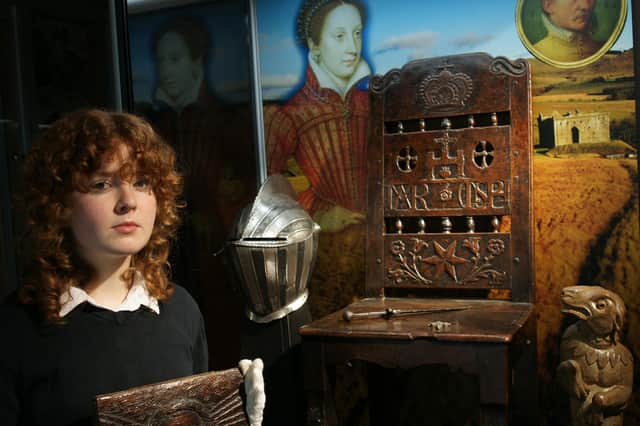Mary Queen of Scots chair returns to her homeland for the first time since 1568


The personal devotional prayer chair has not been in Scotland since Mary’s capture and incarceration in 1568.
It is now to form the centrepiece of an exhibition on the monarch’s life and legacy to be unveiled this spring at the Borderlands Museum at Teviothead.
Advertisement
Hide AdAdvertisement
Hide AdThe exhibition organisers say the chair is subject to a very strict loan agreement, and disclosure of its ownership is not permitted.
Following Mary’s execution in 1587 the chair was most likely secretly recovered by her supporters and has remained hidden ever since.
The exhibition will also include modern commemorative tapestries made by the Royal Ateliers, Hand and Locke, and a musical composition by piper and fiddler Kathryn Tickell, ‘The Highway to Hermitage’, inspired by Mary’s dramatic ride along the prehistoric path, The Queens Mire, to visit her injured lover The Earl of Bothwell at Hermitage Castle.
The Borderlands Museum displays artefacts from the Iron Age through to the age of the Reivers.
Advertisement
Hide AdAdvertisement
Hide AdMeanwhile, Kenneth Erik Moffatt, museum curator, hopes the exhibition will shine a light on the need to protect the area’s cultural heritage.
He has appealed to Scottish Borders councillors to support a call for Teviothead Volcanic Complex to gain protected status.
Although this land today is included in UNESCO’S World Heritage Frontiers of the Roman Empire, it does not as yet have any designated or adequate protection, nor a programme of care.
Mr Moffatt said: “We have made appeals to the Scottish and Westminster Governments, the Scottish affairs committee, MP John Lamont, MSP Rachael Hamilton, and landowner the Duke of Buccleuch, to initiate and support gaining protected status for the Teviothead Volcanic Complex, and for the region to be recognised for its Intangible Cultural Heritage.
Advertisement
Hide AdAdvertisement
Hide Ad“The question has to be asked as to why, to date, no consequent positive response or interest has been taken or expressed for this concept.
“The now impassable prehistoric path, The Queens Mire, which starts in Jedburgh and arrives at Hermitage Castle – runs through the region, where in 1566 Mary Queen of Scots rode in a dramatic journey to visit her injured lover, James Hepburn, The Earl Of Bothwell.
“Mary Queen of Scots is an international female icon, and we believe this route should be preserved and developed as an incredible asset for the Borders.
“The path continues on as the Thieves Road into Northumberland, all the way down to the World Heritage site, Hadrian’s Wall.
Advertisement
Hide AdAdvertisement
Hide Ad“Today these routes, as are many others, are no longer considered even a right of way. We believe The Teviothead Volcanic Complex, these hills we call the ‘Reivers’, are the essence of Intangible Cultural Heritage.
“This Border landscape was created when the two continental plates of Avlona and Laurentia collided in volcanic eruption 480 – 360 million years ago, to create The Teviothead Volcanic Complex, a spur of the Cheviots,.
“A natural fortress, the region was to become a frontier from the Iron Age through to the age of the Border Reivers, the cockpit being Liddesdale, Hermitage Castle and the Debateable land.
“The Scottish Borders has the highest concentration of recorded prehistoric hillforts in the world – 408, with many still as yet unrecorded.
Advertisement
Hide AdAdvertisement
Hide Ad“Popularised by Sir Walter Scott, who took the first wheeled transport into the region when he visited Liddesdale, and his favourite castle, Hermitage, in search of folklore and ballads.
“The region became the muse of many of the great Romantic painters and poets, famously Turner, and its popularity of the Borders continued to be fuelled into the 20th century by Hollywood films such as Ivanhoe, and writers and painters such as Tom Scott, and George Macdonald Fraser with his ‘Steel Bonnets’.
“Largely forgotten today, the majority of this incredible landscape is unexplored in any capacity – neither geologically, archaeologically, environmentally or historically.
“A recent independent comparative study has shown that since records began in the 20th century, 23% of prehistoric archaeology in the Scottish Borders has disappeared, mostly due to blanket forestry, agriculture, and the change in land use (incredibly in Berwickshire the figure is 65%).”
Advertisement
Hide AdAdvertisement
Hide AdGiven that context Mr Moffatt says the recent refusal by SBC to endorse a new National Park was “tragic”, adding: ” We believe that a continued attitude of ignoring the cultural heritage and landscape of the Lower Borders is a dereliction of duty, and that landowners and Government are custodians of the countryside, and whether they like it or not, are entrusted by the people for the care of our heritage and its future, which could become a treasured asset, for the benefit of all.”